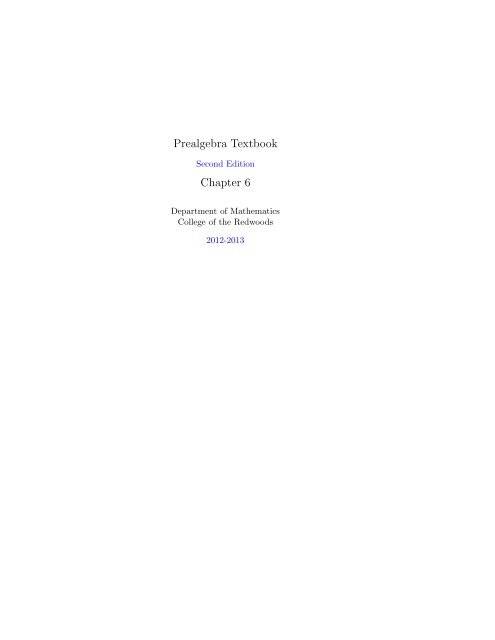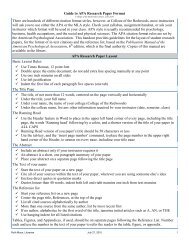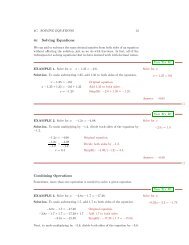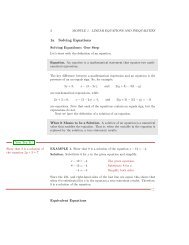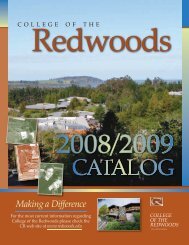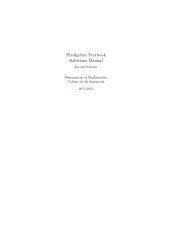Math 376 Prealgebra Textbook - College of the Redwoods
Math 376 Prealgebra Textbook - College of the Redwoods
Math 376 Prealgebra Textbook - College of the Redwoods
You also want an ePaper? Increase the reach of your titles
YUMPU automatically turns print PDFs into web optimized ePapers that Google loves.
ivCONTENTSAnswers . . . . . . . . . . . . . . . . . . . . . . . . . . . . . . 499Index 501
450 CHAPTER 6. RATIO AND PROPORTION(b) To express <strong>the</strong> ratio “0.12:0.18” as a fraction, place 0.12 over 0.18 andreduce.0.120.18 = (0.12)(100)(0.18)(100)= 1218= 2 · 63 · 6= 2 · ✁63 · ✁6Multiply numerator and denominator by 100.Move each decimal 2 places right.Factor.Cancel.= 2 3Answer: 2/5Thus, <strong>the</strong> ratio 0.12:0.18 equals 2/3.□You Try It!A rectangle has length 8 1 4inches and width 3 1 2 inches.Express <strong>the</strong> ratio <strong>of</strong> lengthto width as a fractionreduced to lowest terms.EXAMPLE 2. For <strong>the</strong> rectangle that follows, express <strong>the</strong> ratio <strong>of</strong> length towidth as a fraction reduced to lowest terms.3 1 4 ft 2 1 2 ftSolution. The ratio length to width can be expressed as a fraction and reducedas follows.lengthwidth = 3 1 4 ft2 1 2 ft Length to width as a fraction.= 3 1 4 ft2 1 2 ft134=52Cancel common units.Mixed to improper fractions.
6.1. INTRODUCTION TO RATIOS AND RATES 453Because <strong>the</strong> test digit is greater than or equal to 5, we add 1 to <strong>the</strong> roundingdigit and truncate; i.e., 95/8.5 ≈ 11.18. Hence,95 dollars8.5hours11.18 dollars=1hour=11.18 dollars/hour.Divide: 95/8.5 ≈ 11.18.That is, his salary rate is 11.18 dollars per hour. Answer: $21.82 per hour□You Try It!EXAMPLE 6. One automobile travels 422 miles on 15 gallons <strong>of</strong> gasoline. Asecond automobile travels 354 miles on 13 gallons <strong>of</strong> gasoline. Which automobilegets <strong>the</strong> better gas mileage?Solution. Decimal division (rounded to <strong>the</strong> nearest tenth) reveals <strong>the</strong> bettergas mileage.In <strong>the</strong> case <strong>of</strong> <strong>the</strong> first autombile,we get <strong>the</strong> following rate:In <strong>the</strong> case <strong>of</strong> <strong>the</strong> second autombile,we get <strong>the</strong> following rate:Alicia works 8 hours andmakes $100. Connie works10 hours and makes $122.Which woman works at <strong>the</strong>larger hourly rate?Divide.422 mi15 gal28.1315)422.0030122120201550455Divide.354 mi13 gal27.2313)354.00269491302640391To <strong>the</strong> nearest tenth, 28.1.To <strong>the</strong> nearest tenth, 27.2.In <strong>the</strong> case <strong>of</strong> <strong>the</strong> first automobile, <strong>the</strong> mileage rate is 28.1mi/1 gal, whichcan be read “28.1 miles per gallon.” In <strong>the</strong> case <strong>of</strong> <strong>the</strong> second automobile,<strong>the</strong> mileage rate is 27.2mi/1 gal, which can be read “27.2 miles per gallon.”Therefore, <strong>the</strong> first automobile gets <strong>the</strong> better gas mileage. Answer: Alicia□
❧❧❧454 CHAPTER 6. RATIO AND PROPORTION❧ ❧ ❧ ExercisesIn Exercises 1-24, express <strong>the</strong> given ratio as a fraction reduced to lowest terms.1. 0.14 : 0.442. 0.74 : 0.23. 0.05 : 0.754. 0.78 : 0.45. 0.1 :0.956. 0.93 : 0.397. 2 2 9 :11 38. 3 2 3 :24 99. 0.36 : 0.610. 0.58 : 0.4211. 15:2112. 77 : 12113. 2 8 9 :22 314. 1 2 3 :38 915. 3 8 9 :21 316. 1 5 9 :11 317. 2 5 8 :13 418. 2 4 9 :11 319. 10:3520. 132 : 8421. 9:3322. 35:1023. 27:9924. 12:2825. One automobile travels 271.8 miles on 10.1gallons <strong>of</strong> gasoline. A second automobiletravels 257.9 miles on 11.1 gallons <strong>of</strong> gasoline.Which automobile gets <strong>the</strong> bettergas mileage?26. One automobile travels 202.9 miles on 13.9gallons <strong>of</strong> gasoline. A second automobiletravels 221.6 miles on 11.8 gallons <strong>of</strong> gasoline.Which automobile gets <strong>the</strong> bettergas mileage?27. Todd is paid 183 dollars for 8.25 hourswork. What is his hourly salary rate,rounded to <strong>the</strong> nearest penny?28. David is paid 105 dollars for 8.5 hourswork. What is his hourly salary rate,rounded to <strong>the</strong> nearest penny?29. An automobile travels 140 miles in 4hours. Find <strong>the</strong> average rate <strong>of</strong> speed.30. An automobile travels 120 miles in 5hours. Find <strong>the</strong> average rate <strong>of</strong> speed.31. Judah is paid 187 dollars for 8 hours work.What is his hourly salary rate, rounded to<strong>the</strong> nearest penny?32. Judah is paid 181 dollars for 8.75 hourswork. What is his hourly salary rate,rounded to <strong>the</strong> nearest penny?33. One automobile travels 234.2 miles on 10.8gallons <strong>of</strong> gasoline. A second automobiletravels 270.5 miles on 10.8 gallons <strong>of</strong> gasoline.Which automobile gets <strong>the</strong> bettergas mileage?34. One automobile travels 297.6 miles on 10.7gallons <strong>of</strong> gasoline. A second automobiletravels 298.1 miles on 12.6 gallons <strong>of</strong> gasoline.Which automobile gets <strong>the</strong> bettergas mileage?
❧❧❧6.1. INTRODUCTION TO RATIOS AND RATES 45535. An automobile travels 180 miles in 5hours. Find <strong>the</strong> average rate <strong>of</strong> speed.36. An automobile travels 220 miles in 5hours. Find <strong>the</strong> average rate <strong>of</strong> speed.37. Antarctic trek. Seven women on a 562-mile Antarctic ski trek reached <strong>the</strong> South Pole 38 daysafter <strong>the</strong>y began <strong>the</strong>ir adventure. What was <strong>the</strong> ladies’ average rate <strong>of</strong> speed per day? Round yourresult to <strong>the</strong> nearest tenth <strong>of</strong> a mile. Associated Press-Times-Standard 12/31/09 After 562-mileski trek, seven women reach <strong>the</strong> South Pole.❧ ❧ ❧ Answers1.3.5.7. 5 39. 3 511. 5 772211521913. 131215. 5 319. 2 721.23.31131125. The first automobile has <strong>the</strong> bettermileage per gallon.27. 22.18 dollars/hr29. 35 mi/hr31. 23.38 dollars/hr33. The second automobile has <strong>the</strong> bettermileage per gallon.35. 36 mi/hr17. 3 237. 14.8 miles per day
456 CHAPTER 6. RATIO AND PROPORTION6.2 Introduction to ProportionIn Section 6.1, we introduced <strong>the</strong> concepts or ratio and rate. In this section,we equate <strong>the</strong>se ratios in a construct called a proportion.Proportions. A proportion is a statement that equates two ratios or rates.For example, each <strong>of</strong> <strong>the</strong> equations13 = 2 6 , 15 miles 30 miles=2hours 4hours , and ab = c dcompare two ratios or rates and is a proportion.The proportion13 = 2 6is read “one is to three as two is to six.” The four numbers that make up thisproportion are called <strong>the</strong> terms <strong>of</strong> <strong>the</strong> proportion and are ordered in a naturalmanner.First term −→ 13 = 2 ←− Third termSecond term −→ 6 ←− Fourth termExtremes and Means. The first and fourth terms are called <strong>the</strong> extremes<strong>of</strong> <strong>the</strong> proportion. The second and third terms are called <strong>the</strong> means <strong>of</strong> <strong>the</strong>proportion.In <strong>the</strong> proportionab = c d ,<strong>the</strong> terms a and d are <strong>the</strong> extremes; <strong>the</strong> terms b and c are <strong>the</strong> means.ab = c dextremesab = c dmeansIf we multiply both sides <strong>of</strong> <strong>the</strong> proportion by <strong>the</strong> common denominator,( a) ( cbd = bdb d)<strong>the</strong>n cancel,( a) ( c✁bd = b✁d✁b ✁d)we get <strong>the</strong> following result.ad = bcThis leads to <strong>the</strong> following observation.
6.2. INTRODUCTION TO PROPORTION 457Product <strong>of</strong> Extremes and Means. In <strong>the</strong> proportionab = c d<strong>the</strong> product <strong>of</strong> <strong>the</strong> means equals <strong>the</strong> product <strong>of</strong> <strong>the</strong> extremes. That is,ad = bc.We can get an equivalent result using a technique called cross multiplication.ab = c dProduct <strong>of</strong> means = bcProduct <strong>of</strong> extremes = adYou Try It!EXAMPLE 1. Which <strong>of</strong> <strong>the</strong> following is a valid proportion: (a) 2 3 = 712 ,or Is <strong>the</strong> following a validproportion?(b) 4 9 = 1227 .Solution.(a) Cross multiply23 = 7Product <strong>of</strong> means12to getProduct <strong>of</strong> extremes24=21.Hence, <strong>the</strong> product <strong>of</strong> <strong>the</strong> extremes does not equal <strong>the</strong> product <strong>of</strong> <strong>the</strong>means, so 2/3 =7/12 is not a valid proportion.(b) Cross multiply49 = 12Product <strong>of</strong> means27to getProduct <strong>of</strong> extremes108 = 108.Hence, <strong>the</strong> product <strong>of</strong> <strong>the</strong> extremes equals <strong>the</strong> product <strong>of</strong> <strong>the</strong> means, so4/9 =12/27 is a valid proportion. Answer: No43 = 1611□
458 CHAPTER 6. RATIO AND PROPORTIONSolving ProportionsWe already have all <strong>the</strong> tools needed to solve proportions. Let’s begin with <strong>the</strong>first example.You Try It!Solve <strong>the</strong> proportion for n:23 = n 9EXAMPLE 2. Solve <strong>the</strong> proportion for x:34 = x 12 .Solution. Cross multiply, <strong>the</strong>n solve <strong>the</strong> resulting equation.34 = x 12Original proportion.4 · x =3· 12 Products <strong>of</strong> means and extremes are equal.4x =36 Simplify.4x4 = 364Divide both sides by 4.x =9Simplify.Check. Substitute 9 for x into <strong>the</strong> original proportion and check.34 = x Original proportion.1234 = 9 Substitute 9 for x.12Cross multiply.Answer: 6Thus, <strong>the</strong> solution 9 checks.34 = 9 12Product <strong>of</strong> means = 36Product <strong>of</strong> extremes = 36□You Try It!Solve <strong>the</strong> proportion for m:96 = m 4EXAMPLE 3. Solve <strong>the</strong> proportion for n:32 = 24n .Solution. Cross multiply, <strong>the</strong>n solve <strong>the</strong> resulting equation.32 = 24nOriginal proportion.3 · n =2· 24 Products <strong>of</strong> means and extremes are equal.3n =48 Simplify.3n3 = 483Divide both sides by 3.n =16 Simplify.
6.2. INTRODUCTION TO PROPORTION 459Check. Substitute 16 for n into <strong>the</strong> original proportion and check.Cross multiply.32 = 24n32 = 2416Original proportion.Substitute 16 for n.32 = 2416Product <strong>of</strong> means = 48Product <strong>of</strong> extremes = 48Thus, <strong>the</strong> solution 16 checks. Answer: 6□EXAMPLE 4. Solve <strong>the</strong> proportion for x:2x +115Solution. Cross multiply, <strong>the</strong>n solve <strong>the</strong> resulting equation.2x +1= 1 15 3Original proportion.3(2x + 1) = 15(1) Products <strong>of</strong> means and extremes are equal.6x +3=15 On <strong>the</strong> left, distribute.On <strong>the</strong> right, multiply.6x +3− 3=15− 3 Subtract 3 from both sides.6x =12 Simplify.6x6 = 126Divide both sides by 6.x =2 Simplify both sides.You Try It!= 1 3 . Solve <strong>the</strong> proportion for y:6+2y18= 8 9Check. We’ll leave it to our readers to check this solution. Answer: 5□ApplicationsA number <strong>of</strong> practical applications involve solving a proportion.You Try It!EXAMPLE 5. If 5 oranges cost $1.15, what will be <strong>the</strong> cost for 15 oranges(assuming an equal rate)?If 7 apples cost $3.15, howmuch will 10 apples cost(assuming an equal rate)?
6.2. INTRODUCTION TO PROPORTION 461Solution. Let’s set up <strong>the</strong> proportion with units.1.2cm2mi= 10.6cmx miNote how including <strong>the</strong> units aids in <strong>the</strong> setup <strong>of</strong> <strong>the</strong> proportion. Now, let’sdrop <strong>the</strong> units and solve for x.1.22 = 10.6xOriginal proportion.1.2x = (2)(10.6) Cross multiply.1.2x =21.2 Simplify right-hand side.1.2x1.2 = 21.21.2Divide both sides by 1.2.x ≈ 17.66On <strong>the</strong> right: Divide.We carried <strong>the</strong> division on <strong>the</strong> right one decimal place past <strong>the</strong> tenths place.The rounding digit is a 6 and <strong>the</strong> following test digit is a 6. Add 1 to <strong>the</strong>rounding digit and truncate.To <strong>the</strong> nearest tenth <strong>of</strong> a mile, <strong>the</strong> backpacking route is approximately 17.7miles. Answer: 75 miles□You Try It!EXAMPLE 7. A recipe making 2 dozen cookies requires 1 3 4cups <strong>of</strong> flour,among o<strong>the</strong>r ingredients. If <strong>the</strong> baker wishes to make twice that number <strong>of</strong>cookies, how much flour is required?Solution. Twice 2 dozen is 4 dozen cookies. Let x represent <strong>the</strong> amount <strong>of</strong>flour needed for 4 dozen cookies. Assuming an equal rate for 2 dozen cookies(2 dozen requires 1 3 4cups <strong>of</strong> flour), we set up <strong>the</strong> following proportion. Again,using units helps us craft <strong>the</strong> correct proportion.Dough for 3 pizzas requires8 1 2cups <strong>of</strong> flour. If <strong>the</strong> bakerwishes to make 9 pizzas, howmany cups <strong>of</strong> flour arerequired?2 dozen 4 dozen1 3 =4cups x cupsNote how including <strong>the</strong> units aids in <strong>the</strong> setup <strong>of</strong> <strong>the</strong> proportion. Now, let’sdrop <strong>the</strong> units and solve for x.21 3 4= 4 xOriginal proportion.2x =1 3 4 · 42x = 7 4 · 42x =7Cross multiply.Change to improper fraction.Multiply.
462 CHAPTER 6. RATIO AND PROPORTIONDivide both sides <strong>of</strong> <strong>the</strong> equation by 2 and finish.2x2 = 7 2Divide both sides by 2.x = 7 2Answer: 25 1 2 cups Change <strong>the</strong> improper fraction to a mixed fraction. Thus, it will take 3 1 2 cups<strong>of</strong> flour to make 4 dozen cookies.□
464 CHAPTER 6. RATIO AND PROPORTION34.2x +9935. 7 2 = 21x= 13336.215 = 18x37. If 13 dog bones cost $1.97, what will be <strong>the</strong>cost for 7 dog bones (assuming an equalrate)? Round your answer to <strong>the</strong> nearestpenny.38. If 2 watermelons cost $3.89, what will be<strong>the</strong> cost for 11 watermelons (assuming anequal rate)? Round your answer to <strong>the</strong>nearest penny.39. If 7 bananas cost $2.55, what will be <strong>the</strong>cost for 14 bananas (assuming an equalrate)? Round your answer to <strong>the</strong> nearestpenny.40. If 2 apples cost $2.05, what will be <strong>the</strong>cost for 8 apples (assuming an equal rate)?Round your answer to <strong>the</strong> nearest penny.41. If 13 oranges cost $3.61, what will be <strong>the</strong>cost for 11 oranges (assuming an equalrate)? Round your answer to <strong>the</strong> nearestpenny.42. If 3 watermelons cost $1.05, what will be<strong>the</strong> cost for 9 watermelons (assuming anequal rate)? Round your answer to <strong>the</strong>nearest penny.43. If 3 dog bones cost $1.23, what will be <strong>the</strong>cost for 13 dog bones (assuming an equalrate)? Round your answer to <strong>the</strong> nearestpenny.44. If 3 watermelons cost $4.41, what will be<strong>the</strong> cost for 7 watermelons (assuming anequal rate)? Round your answer to <strong>the</strong>nearest penny.45. If 3 apples cost $3.24, what will be <strong>the</strong> costfor 13 apples (assuming an equal rate)?Round your answer to <strong>the</strong> nearest penny.46. If 6 apples cost $3.43, what will be <strong>the</strong>cost for 7 apples (assuming an equal rate)?Round your answer to <strong>the</strong> nearest penny.47. If 4 dog bones cost $1.03, what will be <strong>the</strong>cost for 8 dog bones (assuming an equalrate)? Round your answer to <strong>the</strong> nearestpenny.48. If 4 oranges cost $4.28, what will be <strong>the</strong>cost for 3 oranges (assuming an equalrate)? Round your answer to <strong>the</strong> nearestpenny.49. Two rolls. In Haiti, two flat rolls cost 5 gourdes, about 12 cents. How many cents would 20 rollscost? Associated Press-Times-Standard 02/18/10 Haiti’s earthquake camps turning into shantytowns.50. Turbines. As proposed, <strong>the</strong> Shell Wind Energy project consists <strong>of</strong> 25 ridge-top turbines that cangenerate up to 50 megawatts, or enough to supply electricity to about 1, 000 homes. Estimate<strong>the</strong> number <strong>of</strong> ridge-top turbines that would be needed to supply electricity to 70, 000 homes,<strong>the</strong> approximate number <strong>of</strong> properties in Humboldt County, CA. John Driscoll Times-Standard12/24/09 Wind power project goes under analysis.
❧❧❧6.2. INTRODUCTION TO PROPORTION 46551. Dumptrucks. U.S. Highway 199 had a landslide where as much as 3, 000 cubic yards <strong>of</strong> materialfell on <strong>the</strong> road, reportedly requiring about 200 large dumptrucks to remove. Only a week earlier,40, 000 cubic yards <strong>of</strong> material fell on Highway 96. Estimate <strong>the</strong> number <strong>of</strong> dumptrucks neededfor that slide rounded to <strong>the</strong> nearest whole number. Associated Press-Times-Standard 03/09/10Ano<strong>the</strong>r highway closed by slide.52. Timber sales. Alaska’s 26, 000 square mile Tongass National Forest plan allows for timber sales<strong>of</strong> up to 267 million board-feet per year – enough for nearly 27, 000 two-bedroom homes, butdemand for timber is far short <strong>of</strong> that. Less than 25 million board-feet was logged in <strong>the</strong> forest in2009. Forest Service <strong>of</strong>ficials have said <strong>the</strong>y hope to increase logging in <strong>the</strong> Tongass to about 100million board-feet per year. Associated Press-Times-Standard 02/18/10 Industry loses lawsuitover logging in Alaska.i) Estimate <strong>the</strong> number <strong>of</strong> 2-bedroom homes that 25 million board-feet <strong>of</strong> timber would build.ii) How many 2-bedroom homes would 100 million board-feet <strong>of</strong> timber build?53. Costly spill. In Australia, penalties on ships causing oil spills are approximately $1.75 millionAustralian dollars, equivalent to about $1.64 million US dollars. After an oil tanker was groundedonto a coral reef, Australian <strong>of</strong>ficials are considering raising <strong>the</strong> fine to $10 million Australiandollars. What will <strong>the</strong> new fine be in US dollars? Round your answer to <strong>the</strong> nearest hundredth<strong>of</strong> a million dollars. Associated Press-Times-Standard 04/13/10 Ship that leaked oil on GreatBarrier Reef removed.❧ ❧ ❧ Answers1. 9 7 = 27 is a proportion213. 7 6 = 28 is a proportion245. 6 5 = 24 is a proportion207. 3 7 = 6 is a proportion149. 5 4 = 25 is a proportion2011. 3 5 = 6 is a proportion1013. 10215. 217. 3419. 4421. 523. 5525. 027. 18029. 3231. 8833. 935. 637. $1.06
466 CHAPTER 6. RATIO AND PROPORTION39. $5.1041. $3.0543. $5.3345. $14.0447. $2.0649. $0.4851. 2, 667 loads53. $9.37 million US dollars
6.3. UNIT CONVERSION: AMERICAN SYSTEM 4676.3 Unit Conversion: American SystemIn this section we will develop a technique for converting units used in <strong>the</strong>American system. We begin with a discussion <strong>of</strong> common measurements <strong>of</strong>length in <strong>the</strong> United States.Units <strong>of</strong> LengthThe most common units <strong>of</strong> length are <strong>the</strong> inch, foot, yard, and mile. Our focuswill be on <strong>the</strong> technique used to convert from one unit <strong>of</strong> length to ano<strong>the</strong>r.American Units <strong>of</strong> Length. Facts relating common units <strong>of</strong> length.1foot (ft)=12inches (in)1 mile (mi) = 5280 feet (ft)1yard (yd)=3feet (ft)Take for example, <strong>the</strong> fact that <strong>the</strong>re are 3 feet in 1 yard, which can bestated as an equation, using <strong>the</strong> common abbreviations for feet (ft) and yards(yd).3ft=1ydIf we divide both sides <strong>of</strong> <strong>the</strong> equation by 3 ft,or equivalently,3ft3ft = 1yd3ft ,1= 1yd3ft .The key observation is <strong>the</strong> fact that <strong>the</strong> ratio 1 yd/3 ft equals <strong>the</strong> number 1.Consequently, multiplying by <strong>the</strong> “conversion factor” 1 yd/3 ft is equivalent tomultiplying by 1. This can be used to change a measurement in feet to yards.You Try It!EXAMPLE 1. Change 36 feet to yards.Change 81 feet to yards.
468 CHAPTER 6. RATIO AND PROPORTIONSolution. Multiply by <strong>the</strong> conversion factor 1 yd/3 ft.36 ft = 36 ft · 1 Multiplicative Identity Property.=36ft· 1yd3ftReplace 1 with 1 yd/3 ft.=36ft · 1yd3 ftCancel common unit.= 36 · 1 yd3Multiply fractions.= 36 yd3Simplify.=12ydDivide.Answer:27 yardsHence, 36 feet equals 12 yards.On <strong>the</strong> o<strong>the</strong>r hand, we can start again with3ft=1yd□and divide both sides <strong>of</strong> <strong>the</strong> equation by 1 yd.3ft1yd = 1yd1ydThis gives <strong>the</strong> conversion factor3ft1yd =1.The key observation is <strong>the</strong> fact that <strong>the</strong> ratio 3 ft/1 yd equals <strong>the</strong> number 1.Consequently, multiplying by <strong>the</strong> “conversion factor” 3 ft/1 yd is equivalent tomultiplying by 1. This can be used to change a measurement in yards to feet.You Try It!Change 15 yards to feet.EXAMPLE 2. Change 18 yards to feet.Solution. Multiply by <strong>the</strong> conversion factor 3 ft/1 yd.18 yd = 18 yd · 1 Multiplicative Identity Property.=18yd· 3ft1ydReplace 1 with 3 ft/1 yd.3ft=18 yd ·1 ydCancel common unit.= 18 · 3 ft1Multiply fractions.=54ftSimplify.
6.3. UNIT CONVERSION: AMERICAN SYSTEM 469Hence, 18 yards equals 54 feet. Answer: 45 feet□Ano<strong>the</strong>r common comparison is <strong>the</strong> fact that <strong>the</strong>re are 12 inches in 1 foot.This can be represented as an equation using <strong>the</strong> common abbreviation forinches (in) and feet (ft).12 in = 1 ftDividing both sides by 12 in12 in12 in = 1ft12 in ,yields <strong>the</strong> conversion factor1= 1ft12 in .The key observation is <strong>the</strong> fact that <strong>the</strong> ratio 1 ft/12 in equals <strong>the</strong> number1. Consequently, multiplying by <strong>the</strong> “conversion factor” 1 ft/12 in is equivalentto multiplying by 1. This can be used to change a measurement in inches t<strong>of</strong>eet.You Try It!EXAMPLE 3. Change 24 inches to feet.Solution. Multiply by <strong>the</strong> conversion factor 1 ft/12 in.Change 48 inches to feet.24 in = 24 in · 1 Multiplicative Identity Property.1ft=24in·12 inReplace 1 with 1 ft/12 in.1ft=24in ·12 inCancel common unit.= 24 · 1 ft12Multiply fractions.=2ftSimplify.Hence, 24 inches equals 2 feet. Answer: 4 feet□We provide a summary <strong>of</strong> conversion factors for units <strong>of</strong> length in Table 6.1.Convert Conversion Factor Convert Conversion Factorfeet to inches 12 in/1 ft inches to feet 1 ft/12 inyards to feet 3ft/1yd feet to yards 1yd/3ftmiles to feet 5280 ft/1 mi feet to miles 1 mi/5280 ftTable 6.1: Conversion factors for units <strong>of</strong> length.Some conversions require more than one application <strong>of</strong> a conversion factor.
470 CHAPTER 6. RATIO AND PROPORTIONYou Try It!Change 8 yards to inches.EXAMPLE 4. Change 4 yards to inches.Solution. We multiply by a chain <strong>of</strong> conversion factors, <strong>the</strong> first to changeyards to feet, <strong>the</strong> second to change feet to inches.Answer:288 inches4yd=4yd· 3ft 12 in ·1yd 1ftMultiply by conversion factors.=4 yd · 3 ft 12 in ·1 yd 1 ftCancel common units.= 4 · 3 · 12 in1 · 1Multiply fractions.= 144 in Simplify.Hence, 4 yards equals 144 inches.□You Try It!Change 5 miles to yards.EXAMPLE 5. Change 2 miles to yards.Solution. We multiply by a chain <strong>of</strong> conversion factors, <strong>the</strong> first to changemiles to feet, <strong>the</strong> second to change feet to yards.Answer:8,800 yards2mi=2mi·5280 ft1mi=2✚✚mi · 5280 ft1 ✚✚mi= 2 · 5280 · 1 yd1 · 3· 1yd3ft· 1yd3 ft= 3520 yd Simplify.Hence, 2 miles equals 3,520 yards.Multiply by conversion factors.Cancel common units.Multiply fractions.□Units <strong>of</strong> WeightThe most common units <strong>of</strong> weight are <strong>the</strong> ounce, pound, and ton. Our focuswill remain on how to convert from one unit to ano<strong>the</strong>r.American Units <strong>of</strong> Weight. Facts relating common units <strong>of</strong> weight.1 pound (lb) = 16 ounces (oz) 1 ton = 2000 pounds (lb)
Hence, 2 1 2 pounds equals 40 ounces. Answer: 100 ounces □6.3. UNIT CONVERSION: AMERICAN SYSTEM 471The above facts lead to <strong>the</strong> conversion factors in Table 6.2.Convert Conversion Factor Convert Conversion Factorpounds to ounces 16 oz/1 lb ounces to pounds 1 lb/16 oztons to pounds 2000 lb/1 ton pounds to tons 1 ton/2000 lbTable 6.2: Conversion factors for units <strong>of</strong> weight.You Try It!EXAMPLE 6. Change 2 1 2pounds to ounces.ChangeSolution. Multiply by <strong>the</strong> appropriate conversion factor.2 1 2 lb = 2 1 16 ozlb · Multiply by conversion factor.2 1lb=2 1 2 16 ozlb · Cancel common units.1 lb=(2 1 )2 · 16 oz Multiply fractions.( ) 5=2 · 16 oz Mixed to improper fraction.= 80 oz Multiply.2=40ozDivide.6 1 4pounds to ounces.You Try It!EXAMPLE 7. Change 3.2 tons to ounces.Solution. This exercise requires multiplying by a chain <strong>of</strong> conversion factors.3.2ton=3.2ton·2000 lb1tonton · 2000 lb16 oz ·1lbMultiply by conversion factors.=3.2 ✟ 16 oz1 ✟ton·1 lbCancel common units.3.2 · 2000 · 16= oz1 · 1Multiply fractions.= 102, 400 oz Simplify.Change 4.1 tons to ounces.Hence, 3.2 tons equals 102,400 ounces. Answer: 128,000 ounces□Units <strong>of</strong> VolumeThe most common units <strong>of</strong> volume are fluid ounces, cups, pints, quarts, andgallons. We will focus on converting from one unit to ano<strong>the</strong>r.
472 CHAPTER 6. RATIO AND PROPORTIONAmerican Units <strong>of</strong> Volume. Facts relating common units <strong>of</strong> volume.1 cup (c) = 8 fluid ounces (fl oz) 1 pint (pt) = 2 cups (c)1 quart (qt) = 2 pints (pt) 1 gallon (gal) = 4 quarts (qt)These facts lead to <strong>the</strong> conversion factors listed in Table 6.3.Convert Conversion Factor Convert Conversion Factorcups to ounces 8 fl oz/1 c ounces to cups 1c/8fl ozpints to cups 2c/1pt cups to pints 1pt/2cquarts to pints 2pt/1qt pints to quarts 1qt/2ptgallons to quarts 4qt/1gal quarts to gallons 1 gal/4 qtTable 6.3: Conversion factors for units <strong>of</strong> volume.You Try It!Change 3.2 gallons to pints.EXAMPLE 8. Change 5.6 gallons to pints.Solution. This exercise requires multiplying by a chain <strong>of</strong> conversion factors.5.6 gal = 5.6 gal · 4qt1 gal · 2pt1qtMultiply by conversion factors.=5.6 ✚ gal · 4 qt1 ✚ gal · 2pt1 qtCancel common units.= 5.6 · 4 · 2 pt1 · 1Multiply fractions.=44.8ptSimiplify.Answer:25.6 pintsHence, 5.6 gallons equals 44.8 pints.□Units <strong>of</strong> TimeThe most common units <strong>of</strong> time are seconds, minutes, hours, days, and years.American Units <strong>of</strong> Time. Facts relating common units <strong>of</strong> time.1 minute (min) = 60 seconds (s) 1 hour (hr) = 60 minutes (min)1 day (day) = 24 hours (hr) 1 year (yr) = 365 days (day)
6.3. UNIT CONVERSION: AMERICAN SYSTEM 473These facts lead to <strong>the</strong> conversion factors in Table 6.4.Convert Conversion Factor Convert Conversion Factorminutes to seconds 60 s/1 min seconds to minutes 1 min/60 shours to minutes 60 min/1 hr minutes to hours 1 hr/60 mindays to hours 24 hr/1 day hours to days 1 day/24 hryears to days 365 day/1 yr days to years 1 yr/365 dayTable 6.4: Conversion factors for units <strong>of</strong> time.EXAMPLE 9. How many seconds in a year?Solution. A chain <strong>of</strong> conversion factors is needed.365 day 24 hr 60 min 60 s1yr=1yr· · · ·1yr 1day 1hr 1minConversion factors.=1✚yr · 365 ✟day✟ 24 ✚hr·1 ✚yr 1 ✟day ✟ ✟min✟ 60 s·1 ✚hr 1 ✟min✟ Cancel common units.1 · 365 · 24 · 60 · 60= s1 · 1 · 1 · 1Multiply fractions.=31, 536, 000 s Simplify.You Try It!How many seconds in a day?Thus, 1 year equals 31,536,000 seconds. Answer: 86,400 seconds□Converting Units <strong>of</strong> SpeedEver wonder how fast a baseball is moving?You Try It!EXAMPLE 10. A pr<strong>of</strong>essional pitcher can throw a baseball at 95 miles perhour. How fast is this in feet per second? Round your answer to <strong>the</strong> nearestfoot per second.Solution. There are 5280 feet in a mile, 60 minutes in an hour, and 60 secondsin a minute.95 mi mi 5280 ft 1h≈ 95 · ·h h 1mi 60 min · 1min Conversion factors.60 s≈ 95 ✚ ✚mi 5280 ft 1 ✁h· ·✁h 1 ✚✚mi 60 ✟min ✟ · 1 ✟min✟Cancel common units.60 s95 · 5280 · 1 · 1 ft≈ Multiply fractions.1 · 60 · 60 s≈ 139.3 ft Multiply and divide.sA women’s s<strong>of</strong>tball pitchercan throw her fastball at 60miles per hour. How fast isthis in feet per second?Round your answer to <strong>the</strong>nearest foot per second.
474 CHAPTER 6. RATIO AND PROPORTIONAnswer:88 feet per secondTo round to <strong>the</strong> nearest foot per second, identify <strong>the</strong> rounding and test digits.Rounding digit13 9 . 3Test digitBecause <strong>the</strong> test digit is less than 5, leave <strong>the</strong> rounding digit alone and truncate.Thus, to <strong>the</strong> nearest foot per second, <strong>the</strong> speed is approximately 139 feet persecond.Whew! Since <strong>the</strong> batter stands at home plate, which is about 60 feet fromwhere <strong>the</strong> pitch is delivered, <strong>the</strong> batter has less than 1/2 a second to react to<strong>the</strong> pitch!□
❧❧❧6.3. UNIT CONVERSION: AMERICAN SYSTEM 475❧ ❧ ❧ Exercises1. Change 8 yards to feet.2. Change 60 yards to feet.3. Change 261 feet to yards.4. Change 126 feet to yards.5. Change 235 inches to yards. Round youranswer to <strong>the</strong> nearest tenth <strong>of</strong> a yard.6. Change 244 inches to yards. Round youranswer to <strong>the</strong> nearest tenth <strong>of</strong> a yard.7. Change 141 feet to yards.8. Change 78 feet to yards.9. Change 2.8 miles to feet.10. Change 4.9 miles to feet.11. Change 104 inches to yards. Round youranswer to <strong>the</strong> nearest tenth <strong>of</strong> a yard.12. Change 101 inches to yards. Round youranswer to <strong>the</strong> nearest tenth <strong>of</strong> a yard.13. Change 168,372 inches to miles, correct to<strong>the</strong> nearest tenth <strong>of</strong> a mile.14. Change 198,550 inches to miles, correct to<strong>the</strong> nearest tenth <strong>of</strong> a mile.15. Change 82 feet to inches.16. Change 80 feet to inches.17. Change 2.9 yards to inches. Round youranswer to <strong>the</strong> nearest inch.18. Change 4.5 yards to inches. Round youranswer to <strong>the</strong> nearest inch.19. Change 25,756 feet to miles. Round youranswer to <strong>the</strong> nearest tenth <strong>of</strong> a mile.20. Change 19,257 feet to miles. Round youranswer to <strong>the</strong> nearest tenth <strong>of</strong> a mile.21. Change 5 yards to feet.22. Change 20 yards to feet.23. Change 169,312 inches to miles, correct to<strong>the</strong> nearest tenth <strong>of</strong> a mile.24. Change 162,211 inches to miles, correct to<strong>the</strong> nearest tenth <strong>of</strong> a mile.25. Change 1.5 yards to inches. Round youranswer to <strong>the</strong> nearest inch.26. Change 2.1 yards to inches. Round youranswer to <strong>the</strong> nearest inch.27. Change 360 inches to feet.28. Change 768 inches to feet.29. Change 48 inches to feet.30. Change 528 inches to feet.31. Change 15,363 feet to miles. Round youranswer to <strong>the</strong> nearest tenth <strong>of</strong> a mile.32. Change 8,540 feet to miles. Round youranswer to <strong>the</strong> nearest tenth <strong>of</strong> a mile.33. Change 1.7 miles to inches.34. Change 4.7 miles to inches.35. Change 3.1 miles to inches.36. Change 1.8 miles to inches.37. Change 3.6 miles to feet.38. Change 3.1 miles to feet.39. Change 18 feet to inches.40. Change 33 feet to inches.
476 CHAPTER 6. RATIO AND PROPORTION41. Change 5 1 8pounds to ounces.42. Change 3 116pounds to ounces.43. Change 2.4 tons to ounces.44. Change 3.4 tons to ounces.45. Change 34 ounces to pounds. Expressyour answer as a fraction reduced to lowestterms.46. Change 78 ounces to pounds. Expressyour answer as a fraction reduced to lowestterms.47. Change 2.2 tons to pounds.48. Change 4.8 tons to pounds.49. Change 70 ounces to pounds. Expressyour answer as a fraction reduced to lowestterms.50. Change 20 ounces to pounds. Expressyour answer as a fraction reduced to lowestterms.51. Change 9,560 pounds to tons. Round youranswer to <strong>the</strong> nearest tenth <strong>of</strong> a ton.52. Change 9,499 pounds to tons. Round youranswer to <strong>the</strong> nearest tenth <strong>of</strong> a ton.53. Change 2 1 2pounds to ounces.54. Change 7 1 16pounds to ounces.55. Change 5.9 tons to pounds.56. Change 2.1 tons to pounds.57. Change 2.5 tons to ounces.58. Change 5.3 tons to ounces.59. Change 8,111 pounds to tons. Round youranswer to <strong>the</strong> nearest tenth <strong>of</strong> a ton.60. Change 8,273 pounds to tons. Round youranswer to <strong>the</strong> nearest tenth <strong>of</strong> a ton.61. Change 4.5625 pints to fluid ounces.62. Change 2.9375 pints to fluid ounces.63. Change 32 fluid ounces to pints.64. Change 160 fluid ounces to pints.65. Change 3.7 gallons to pints.66. Change 2.4 gallons to pints.67. Change 216 pints to gallons.68. Change 96 pints to gallons.69. Change 544 fluid ounces to pints.70. Change 432 fluid ounces to pints.71. Change 112 pints to gallons.72. Change 200 pints to gallons.73. Change 7.7 gallons to pints.74. Change 5.7 gallons to pints.75. Change 3.875 pints to fluid ounces.76. Change 3 pints to fluid ounces.77. Change 7.8 years to hours.78. Change 4.7 years to hours.79. Change 7.6 years to hours.80. Change 6.6 years to hours.81. Change 4,025,005 seconds to days. Roundyour answer to <strong>the</strong> nearest tenth <strong>of</strong> a day.82. Change 4,672,133 seconds to days. Roundyour answer to <strong>the</strong> nearest tenth <strong>of</strong> a day.83. Change 37,668 hours to years.84. Change 40,296 hours to years.85. Change 22,776 hours to years.86. Change 29,784 hours to years.
❧❧❧6.3. UNIT CONVERSION: AMERICAN SYSTEM 47787. Change 96 days to seconds.88. Change 50 days to seconds.89. Change 40 days to seconds.90. Change 10 days to seconds.91. Change 3,750,580 seconds to days. Roundyour answer to <strong>the</strong> nearest tenth <strong>of</strong> a day.92. Change 4,493,469 seconds to days. Roundyour answer to <strong>the</strong> nearest tenth <strong>of</strong> a day.93. Change 367 feet per second to miles perhour. Round your answer to <strong>the</strong> nearestmile per hour.94. Change 354 feet per second to miles perhour. Round your answer to <strong>the</strong> nearestmile per hour.95. Change 442 feet per second to miles perhour. Round your answer to <strong>the</strong> nearestmile per hour.96. Change 388 feet per second to miles perhour. Round your answer to <strong>the</strong> nearestmile per hour.97. Change 30 miles per hour to feet per second.Round your answer to <strong>the</strong> nearestfoot per second.98. Change 99 miles per hour to feet per second.Round your answer to <strong>the</strong> nearestfoot per second.99. Change 106 miles per hour to feet per second.Round your answer to <strong>the</strong> nearestfoot per second.100. Change 119 miles per hour to feet per second.Round your answer to <strong>the</strong> nearestfoot per second.101. Strong man. Famed strongman Joe Rollino, who was still bending quarters with his fingers atage 104, once lifted 3, 200 pounds at Coney Island Amusement Park. How many tons did Joeliftthatday?Associated Press-Times-Standard 01/12/10 NYC amusement park strongman, 104,killed by van.102. Earth day. The amount <strong>of</strong> time it takes <strong>the</strong> Earth to rotate once around its axis is one day.How many seconds is that?103. Water break. “The average age <strong>of</strong> Washington, DC’s water pipes is 76 years, and <strong>the</strong>y are notalone. Every two minutes, somewhere in <strong>the</strong> country, a pipe breaks.” How many pipes break eachyear in <strong>the</strong> US? New York Times 03/14/10 Saving U.S. water and sewer systems could be costly.❧ ❧ ❧ Answers1. 24 feet3. 87 yards5. 6.5 yards7. 47 yards9. 14,784 feet11. 2.9 yards
478 CHAPTER 6. RATIO AND PROPORTION13. 2.7 miles15. 984 inches17. 104 inches19. 4.9 miles21. 15 feet23. 2.7 miles25. 54 inches27. 30 feet29. 4 feet31. 2.9 miles33. 107,712 inches35. 196,416 inches37. 19,008 feet39. 216 inches41. 82 ounces43. 76,800 ounces45. 2 1 8 pounds47. 4,400 pounds49. 4 3 8 pounds51. 4.8 tons53. 40 ounces55. 11,800 pounds57. 80,000 ounces59. 4.1 tons61. 73 fluid ounces63. 2pints65. 29.6 pints67. 27 gallons69. 34 pints71. 14 gallons73. 61.6 pints75. 62 fluid ounces77. 68,328 hours79. 66,576 hours81. 46.6 days83. 4.3 years85. 2.6 years87. 8,294,400 seconds89. 3,456,000 seconds91. 43.4 days93. 250 mi/hr95. 301 mi/hr97. 44 ft/s99. 155 ft/s101. 1.6 tons103. 262, 800
6.4. UNIT CONVERSION: METRIC SYSTEM 4796.4 Unit Conversion: Metric SystemThe metric system <strong>of</strong> units is <strong>the</strong> standard system <strong>of</strong> units preferred by scientists.It is based on <strong>the</strong> base ten number system and its decimal format ismore friendly to users <strong>of</strong> this system.There is a common set <strong>of</strong> prefixes adopted by <strong>the</strong> metric system to indicatea power <strong>of</strong> ten to apply to <strong>the</strong> base unit.Metric System Prefixes. This is a list <strong>of</strong> standard prefixes for <strong>the</strong> metricsystem and <strong>the</strong>ir meanings.deka = 10 deci = 1/10hecto = 100 centi = 1/100kilo = 1000 milli = 1/1000Thus, for example, a decameter is 10 meters, a hectoliter is 100 liters, and akilogram is 1000 grams. Similarly, a decimeter is 1/10 <strong>of</strong> a meter, a centiliteris 1/100 <strong>of</strong> a liter, and a milligram is 1/1000 <strong>of</strong> a gram.Units <strong>of</strong> LengthThe standard measure <strong>of</strong> length in <strong>the</strong> metric system is <strong>the</strong> meter.Historically, <strong>the</strong> meter was defined by <strong>the</strong> French Academy <strong>of</strong> Sciencesas <strong>the</strong> length between two marks on a platinum-iridium bar,which was designed to represent 110,000,000 <strong>of</strong> <strong>the</strong> distance from<strong>the</strong> equator to <strong>the</strong> north pole through Paris. In 1983, it was redefinedby <strong>the</strong> International Bureau <strong>of</strong> Weights and Measures (BIPM)as <strong>the</strong> distance travelled by light in free space in 1299,792,458 <strong>of</strong> asecond. (Wikipedia)We can apply <strong>the</strong> standard prefixes to get <strong>the</strong> following result.Metric Units <strong>of</strong> Length. These units <strong>of</strong> length are used in <strong>the</strong> metric system.Unit LengthUnit Abbreviation1 kilometer = 1000 meters km1 hectometer = 100 meters hm1 dekameter = 10 meters dam1 meter m1 decimeter = 110meter dm1 centimeter = 1100meter cm1 millimeter = 11000meter mm
480 CHAPTER 6. RATIO AND PROPORTIONWe can use <strong>the</strong>se facts to build conversion factors as we did in Section 6.3.For example, because1 km = 1000 m,we can divide both sides by 1000 m to produce <strong>the</strong> conversion factor1= 1km1000 m .This conversion factor can help change meters into kilometers.Before using this conversion factor in an example, we repeat here <strong>the</strong> rulesfor multiplying and dividing by powers <strong>of</strong> ten. We will be making heavy use <strong>of</strong><strong>the</strong>se rules in this section.Multiplying and Dividing by Powers <strong>of</strong> Ten.• Multiplying a decimal number by 10 n will move <strong>the</strong> decimal point nplaces to <strong>the</strong> right. For example, 3.2567 · 10 2 =3.2567 · 100 = 325.67.• Dividing a decimal number by 10 n will move <strong>the</strong> decimal point n placesto <strong>the</strong> left. For example, 3.2567/10 2 =3.2567/100 = 0.032567.And now <strong>the</strong> example.You Try It!Change 1,156 meters tokilometers.EXAMPLE 1. Change 2,326 meters to kilometers.Solution. Multiply by <strong>the</strong> conversion factor 1 km/1000 m.1km2326 m = 2326 m ·1000 mApply conversion factor.1km= 2326 ✚m ·1000 ✚mCancel common units.= 2326 · 1 km1000Multiply fractions.=2.326 km Simplify.In <strong>the</strong> last step, note that dividing by 1000 moves <strong>the</strong> decimal point threeplaces to <strong>the</strong> left. Thus, 2326 meters is equal to 2.326 kilometers.Alternate Solution. A second solution depends upon <strong>the</strong> fact that multiplyingor dividing by a power <strong>of</strong> ten will move <strong>the</strong> decimal point right or lefta number <strong>of</strong> places equal to <strong>the</strong> number <strong>of</strong> zeros present in <strong>the</strong> multiplier ordivisor. Thus, as we saw above, dividing by 1000 moved <strong>the</strong> decimal point 3places to <strong>the</strong> left.Suppose that we arrange <strong>the</strong> metric units <strong>of</strong> length in order, from largestto smallest, as shown below.
6.4. UNIT CONVERSION: METRIC SYSTEM 481km hm dam m dm cm mmNote that we must move 3 places left to move from <strong>the</strong> meters (m) abbreviationto <strong>the</strong> kilometers (km) abbreviation. In like manner, if we write 2,326 metersas 2,326.0 meters, <strong>the</strong>n we can convert to kilometers by moving <strong>the</strong> decimal 3places to <strong>the</strong> left.2, 326.0m=2.236 0 km = 2.326 kmAnswer:1.156 kilometers□You Try It!EXAMPLE 2. Change 537 centimeters to meters.Solution. We know that1cm= 1100 m,or multiplying both sides <strong>of</strong> this result by 100,Change 276 centimeters tometers.100 cm = 1 m.Dividing both sides <strong>of</strong> this last result by 100 cm, we obtain <strong>the</strong> conversion factor1 m/100 cm.1m537 cm = 537 cm ·100 cmApply conversion factor.1m= 537 ✟✟ cm ·100 ✟✟ cmCancel common units.= 537 · 1 m100Multiply fractions.=5.37 mIn <strong>the</strong> last step, note that dividing by 100 moves <strong>the</strong> decimal point two placesto <strong>the</strong> left.Alternately, we can set up our ordered list <strong>of</strong> units.km hm dam m dm cm mmNote that we must move 2 places left to move from <strong>the</strong> centimeters (cm)abbreviation to <strong>the</strong> meters (m) abbreviation. In like manner, if we write537 centimeters as 537.0 centimeters, <strong>the</strong>n we can convert to meters by moving<strong>the</strong> decimal 2 places to <strong>the</strong> left.537.0cm=5.37 0 m = 5.37 mAnswer:2.76 meters□
482 CHAPTER 6. RATIO AND PROPORTIONSometimes more than one conversion factor is needed.You Try It!Change 13.5 dekameters tocentimeters.EXAMPLE 3. Change 10.2 dekameters to centimeters.Solution. We have two facts:• 1 dam=10 m, which yields <strong>the</strong> conversion factor 10 m/1 dam.• 1 cm=(1/100) m or 100 cm=1 m, which yields <strong>the</strong> conversion factor100 cm/1 m.10 m 100 cm10.2dam=10.2dam· ·1dam 1m=10.2 ✘ dam ✘ 10 ✚m 100 cm·1 ✘ dam ✘ ·1 ✚m10.2 · 10 · 100= cm1 · 1=10, 200 cmApply conversion factors.Cancel common units.Multiply fractions.Answer:13,500 centimetersIn <strong>the</strong> last step, note that multiplying by 10, <strong>the</strong>n by 100, moves <strong>the</strong> decimalpoint three places to <strong>the</strong> right.Alternately, we can set up our ordered list <strong>of</strong> units.km hm dam m dm cm mmNote that we must move 3 places right to move from <strong>the</strong> dekameters (dam)abbreviation to <strong>the</strong> centimeters (cm) abbreviation. In like manner, we canconvert 10.2 dekameters to centimeters by moving <strong>the</strong> decimal 3 places to <strong>the</strong>right.10.2 dam = 10 200 cm = 10, 200 cm□Units <strong>of</strong> MassThe fundamental unit <strong>of</strong> mass in <strong>the</strong> metric system is called a gram. Originally,it was defined to be equal to one cubic centimeter <strong>of</strong> water measured at <strong>the</strong>temperature <strong>of</strong> melting ice. Now it is simply defined as 1/1000 <strong>of</strong> a kilogram,which is defined by a physical prototype preserved by <strong>the</strong> International Bureau<strong>of</strong> Weights and Measures (Wikipedia). The mass <strong>of</strong> an object is not <strong>the</strong> sameas an object’s weight, but ra<strong>the</strong>r a resistance to motion when an external forceis applied.The same metric system prefixes apply.
6.4. UNIT CONVERSION: METRIC SYSTEM 483Metric Units <strong>of</strong> Mass. These units <strong>of</strong> mass are used in <strong>the</strong> metric system.Unit <strong>of</strong> MassUnit Abbreviationgram mg1 kilogram = 1000 grams kg1 hectogram = 100 grams hg1 dekagram = 10 grams dag1gramg1 decigram = 110gram dg1 centigram = 1100gram cg1 milligram = 11000You Try It!EXAMPLE 4. Convert 0.025 dekagrams to milligrams.Solution. We’ll use two conversion factors:• 1 dag=10 g, which yields <strong>the</strong> conversion factor 10 g/1 dag.• 1 mg=(1/1000)g, which yields <strong>the</strong> conversion factor 1000 mg/1 g.Convert 0.05 dekagrams tomilligrams.10 g0.025 dag = 0.025 dag ·1dag=0.025 ✟dag ✟ 10· ✁ g1 ✟dag ✟0.025 · 10 · 1000= mg1 · 1= 250 mg· 1000 mg1g· 1000 mg1 ✁ gAlternately, we can set up our ordered list <strong>of</strong> units.Apply conversion factors.Cancel common units.Multiply fractions.kg hg dag g dg cg mgNote that we must move 4 places right to move from <strong>the</strong> dekagrams (dag)abbreviation to <strong>the</strong> milligrams (mg) abbreviation. In like manner, we canconvert 0.025 dekagrams to milligrams by moving <strong>the</strong> decimal 4 places to <strong>the</strong>right.0.0250 dag = 0 0250. mg = 250 mgAnswer:500 milligrams□
484 CHAPTER 6. RATIO AND PROPORTIONUnits <strong>of</strong> VolumeThe fundamental unit <strong>of</strong> volume in <strong>the</strong> metric system is called a litre. Originally,one litre was defined as <strong>the</strong> volume <strong>of</strong> one kilogram <strong>of</strong> water measuredat 4 ◦ C at 760 millimeters <strong>of</strong> mercury (Wikipedia). Currently, 1 litre is definedas 1 cubic decimeter (imagine a cube with each edge 1/10 <strong>of</strong> a meter).The same metric system prefixes apply.Metric Units <strong>of</strong> Volume.system.Unit <strong>of</strong> VolumeThese units <strong>of</strong> volume are used in <strong>the</strong> metricUnit Abbreviation1 kilolitre = 1000 litres kL1 hectolitre = 100 litres hL1 dekalitre = 10 litres daL1 litre L1 decilitre = 110litre dL1 centilitre = 1100litre cL1 millilitre = 11000litre mLYou Try It!Convert 5,763 millilitres todekalitres.EXAMPLE 5. Convert 11,725 millilitres to dekalitres.Solution. We’ll use two conversion factors:• 1 daL=10 L, which yields <strong>the</strong> conversion factor 1 daL/10 L.• 1 mL=(1/1000) L, which yields <strong>the</strong> conversion factor 1 L/1000 mL.1L11, 725 mL = 11, 725 mL ·1000 mL · 1daL10 L=11, 725 ✟mL 1 ✓L·1000 ✟mL · 1daL10 ✓L11, 725 · 1 · 1= daL1000 · 10=1.1725 daLApply conversion factors.Cancel common units.Multiply fractions.Alternately, we can set up our ordered list <strong>of</strong> units.kL hL daL L dL cL mL
6.4. UNIT CONVERSION: METRIC SYSTEM 485Note that we must move 4 places left to move from <strong>the</strong> millitres (mL)abbreviation to <strong>the</strong> dekalitres (daL) abbreviation. In like manner, we canconvert 11,725 millilitres to dekalitres by moving <strong>the</strong> decimal 4 places to <strong>the</strong>left.11, 725.0mL=1.1725 0 daL = 1.1725 daLAnswer:0.5763 dekalitres□
❧❧❧486 CHAPTER 6. RATIO AND PROPORTION❧ ❧ ❧ Exercises1. What is <strong>the</strong> meaning <strong>of</strong> <strong>the</strong> metric systemprefix centi?2. What is <strong>the</strong> meaning <strong>of</strong> <strong>the</strong> metric systemprefix deka?3. What is <strong>the</strong> meaning <strong>of</strong> <strong>the</strong> metric systemprefix hecto?4. What is <strong>the</strong> meaning <strong>of</strong> <strong>the</strong> metric systemprefix kilo?5. What is <strong>the</strong> meaning <strong>of</strong> <strong>the</strong> metric systemprefix deci?6. What is <strong>the</strong> meaning <strong>of</strong> <strong>the</strong> metric systemprefix milli?7. What is <strong>the</strong> meaning <strong>of</strong> <strong>the</strong> metric systemabbreviation mg?8. What is <strong>the</strong> meaning <strong>of</strong> <strong>the</strong> metric systemabbreviation g?9. What is <strong>the</strong> meaning <strong>of</strong> <strong>the</strong> metric systemabbreviation m?10. What is <strong>the</strong> meaning <strong>of</strong> <strong>the</strong> metric systemabbreviation km?11. What is <strong>the</strong> meaning <strong>of</strong> <strong>the</strong> metric systemabbreviation kL?12. What is <strong>the</strong> meaning <strong>of</strong> <strong>the</strong> metric systemabbreviation daL?13. What is <strong>the</strong> meaning <strong>of</strong> <strong>the</strong> metric systemabbreviation hm?14. What is <strong>the</strong> meaning <strong>of</strong> <strong>the</strong> metric systemabbreviation dm?15. What is <strong>the</strong> meaning <strong>of</strong> <strong>the</strong> metric systemabbreviation dam?16. What is <strong>the</strong> meaning <strong>of</strong> <strong>the</strong> metric systemabbreviation cm?17. What is <strong>the</strong> meaning <strong>of</strong> <strong>the</strong> metric systemabbreviation dL?18. What is <strong>the</strong> meaning <strong>of</strong> <strong>the</strong> metric systemabbreviation L?19. What is <strong>the</strong> meaning <strong>of</strong> <strong>the</strong> metric systemabbreviation hg?20. What is <strong>the</strong> meaning <strong>of</strong> <strong>the</strong> metric systemabbreviation kg?21. What is <strong>the</strong> meaning <strong>of</strong> <strong>the</strong> metric systemabbreviation dg?22. What is <strong>the</strong> meaning <strong>of</strong> <strong>the</strong> metric systemabbreviation dag?23. What is <strong>the</strong> meaning <strong>of</strong> <strong>the</strong> metric systemabbreviation hL?24. What is <strong>the</strong> meaning <strong>of</strong> <strong>the</strong> metric systemabbreviation cL?25. Change 5,490 millimeters to meters.26. Change 8,528 millimeters to meters.27. Change 64 meters to millimeters.28. Change 65 meters to millimeters.29. Change 4,571 millimeters to meters.30. Change 8,209 millimeters to meters.31. Change 15 meters to centimeters.32. Change 12 meters to centimeters.33. Change 569 centimeters to meters.34. Change 380 centimeters to meters.
6.4. UNIT CONVERSION: METRIC SYSTEM 48735. Change 79 meters to centimeters.36. Change 60 meters to centimeters.37. Change 7.6 kilometers to meters.38. Change 4.9 kilometers to meters.39. Change 861 centimeters to meters.40. Change 427 centimeters to meters.41. Change 4,826 meters to kilometers.42. Change 1,929 meters to kilometers.43. Change 4,724 meters to kilometers.44. Change 1,629 meters to kilometers.45. Change 6.5 kilometers to meters.46. Change 7.9 kilometers to meters.47. Change 17 meters to millimeters.48. Change 53 meters to millimeters.49. Change 512 milligrams to centigrams.50. Change 516 milligrams to centigrams.51. Change 541 milligrams to centigrams.52. Change 223 milligrams to centigrams.53. Change 70 grams to centigrams.54. Change 76 grams to centigrams.55. Change 53 centigrams to milligrams.56. Change 30 centigrams to milligrams.57. Change 83 kilograms to grams.58. Change 70 kilograms to grams.59. Change 8,196 grams to kilograms.60. Change 6,693 grams to kilograms.61. Change 564 centigrams to grams.62. Change 884 centigrams to grams.63. Change 38 grams to centigrams.64. Change 88 grams to centigrams.65. Change 77 centigrams to milligrams.66. Change 61 centigrams to milligrams.67. Change 5,337 grams to kilograms.68. Change 4,002 grams to kilograms.69. Change 15 kilograms to grams.70. Change 45 kilograms to grams.71. Change 833 centigrams to grams.72. Change 247 centigrams to grams.73. Change 619,560 centilitres to kilolitres.74. Change 678,962 centilitres to kilolitres.75. Change 15.2 litres to millilitres.76. Change 9.7 litres to millilitres.77. Change 10,850 centilitres to litres.78. Change 15,198 centilitres to litres.79. Change 10.7 litres to millilitres.80. Change 17.3 litres to millilitres.81. Change 15,665 millilitres to litres.82. Change 12,157 millilitres to litres.83. Change 6.3 kilolitres to centilitres.84. Change 8.3 kilolitres to centilitres.85. Change 4.5 kilolitres to centilitres.86. Change 6.2 kilolitres to centilitres.87. Change 10.6 litres to centilitres.88. Change 16.6 litres to centilitres.89. Change 14,383 centilitres to litres.90. Change 11,557 centilitres to litres.
❧❧❧488 CHAPTER 6. RATIO AND PROPORTION91. Change 9.9 litres to centilitres.92. Change 19.5 litres to centilitres.93. Change 407,331 centilitres to kilolitres.94. Change 827,348 centilitres to kilolitres.95. Change 14,968 millilitres to litres.96. Change 18,439 millilitres to litres.❧ ❧ ❧ Answers1. 1/1003. 1005. 1/107. milligram9. meter11. kilolitre or kiloliter13. hectometer15. dekameter17. decilitre or deciliter19. hectogram21. decigram23. hectolitre or hectoliter25. 5.49 meters27. 64,000 millimeters29. 4.571 meters31. 1,500 centimeters33. 5.69 meters35. 7,900 centimeters37. 7,600 meters39. 8.61 meters41. 4.826 kilometers43. 4.724 kilometers45. 6,500 meters47. 17,000 millimeters49. 51.2 centigrams51. 54.1 centigrams53. 7,000 centigrams55. 530 milligrams57. 83,000 grams59. 8.196 kilograms61. 5.64 grams63. 3,800 centigrams65. 770 milligrams67. 5.337 kilograms69. 15,000 grams71. 8.33 grams73. 6.1956 kilolitres75. 15,200 millilitres77. 108.5 litres
6.4. UNIT CONVERSION: METRIC SYSTEM 48979. 10,700 millilitres81. 15.665 litres83. 630,000 centilitres85. 450,000 centilitres87. 1,060 centilitres89. 143.83 litres91. 990 centilitres93. 4.07331 kilolitres95. 14.968 litres
490 CHAPTER 6. RATIO AND PROPORTION6.5 American Units to Metric Units and Vice-VersaWe <strong>of</strong>ten need to convert from <strong>the</strong> American system <strong>of</strong> units to <strong>the</strong> metricsystem <strong>of</strong> units or vice-versa (imagine traveling to a European country using<strong>the</strong> metric system). That will be our focus in this section.Converting Units <strong>of</strong> LengthOne meter is slightly longer than one yard. Indeed,1m≈ 1.0936 yd.If we divide both sides <strong>of</strong> this equation by 1.0936, <strong>the</strong>n1m 1.0936 yd≈1.0936 1.09360.9144 m ≈ 1ydFur<strong>the</strong>r conversions can be made. For example, to change meters to feet, wemake <strong>the</strong> following conversions.1m≈ 1m·1yd0.9144m · 3ft1ydApply conversion factors.1≈ 1 ✚m · yd0.9144✚m · 3ft1 ydCancel common units.≈ 1 · 1 · 3 ft0.9144 · 1Multiply fractions.≈ 3.2808 ftTable 6.5 shows some <strong>of</strong> <strong>the</strong> most common conversions between American units<strong>of</strong> length and metric units <strong>of</strong> length.American to MetricMetric to American1in≈ 2.54 cm1 cm ≈ 0.3937 in1ft≈ 0.3048 m1 m ≈ 3.2808 ft1yd≈ 0.9144 m1 m ≈ 1.0936 yd1mi≈ 1.6093 km1 km ≈ 0.6214 miTable 6.5: Length conversions: American — Metric.You Try It!Change 227 miles tokilometers. Round to <strong>the</strong>nearest tenth <strong>of</strong> a kilometer.EXAMPLE 1. A car’s speedometer shows that a family has currently traveled154 miles in route to <strong>the</strong>ir vacation destination. Convert this distance tokilometers.
6.5. AMERICAN UNITS TO METRIC UNITS AND VICE-VERSA 491Solution. Choose 1 mi = 1.6093 km from Table 6.5.1.6093 km154 mi ≈ 154 mi · Apply conversion factor.1mi1.6093 km≈ 154 ✚✚mi · Cancel common units.1 ✚✚mi154 · 1.6093≈ kmMultiply fractions.1≈ 247.8kmHence, 154 miles is approximately 247.8 kilometers.Alternate Solution. Note that this would work equally well if we chose1km≈ 0.6214 mi from Table 6.5.1km154 mi ≈ 154 mi ·Apply conversion factor.0.6214 mi1km≈ 154 ✚✚mi ·Cancel common units.0.6214 ✚✚mi≈ 154 · 1 km Multiply fractions.0.6214≈ 247.8kmAnswer:365.3 kilometers□Converting Units <strong>of</strong> Weight and MassIt is known that1kg≈ 2.2lb.Dividing both sides <strong>of</strong> this equation by 2.2,1kg2.2 ≈ 2.2lb2.20.454 kg ≈ 1lbA summary <strong>of</strong> <strong>the</strong> more common conversion factors regarding mass and weightare given in Table 6.6.American to Metric1oz≈ 28.35 g1lb≈ 0.454 kgMetric to American1 g ≈ 0.035 oz1 kg ≈ 2.2lbTable 6.6: Mass—Weight conversions: American — Metric.
492 CHAPTER 6. RATIO AND PROPORTIONYou Try It!Change 5.7 kilograms toounces. Round to <strong>the</strong>nearest ounce.EXAMPLE 2. Change 2.3 kilograms to ounces.Solution. One kilogram weighs 2.2 pounds and <strong>the</strong>re are 16 ounces in a pound.2.3kg≈ 2.3kg· 2.2lb1kg· 16 oz1lb≈ 2.3 kg · 2.2 lb 16 oz ·1 kg 1 lb2.3 · 2.2 · 16≈ oz1 · 1≈ 80.96 ozApply conversion factors.Cancel common units.Multiply fractions.Hence, 2.3 kilograms weighs 80.96 ounces.Alternate Solution. Ano<strong>the</strong>r approach uses <strong>the</strong> facts that 1 kilogram equals1000 grams and 1 ounce equals 28.35 grams.2.3kg≈ 2.3kg· 1000 g1kg ·≈ 2.3 kg · 1000 ✁ g1 kg ·2.3 · 1000 · 1≈ oz1 · 28.35≈ 81.13 oz1oz28.35 g1oz28.35 ✁ gApply conversion factors.Cancel common units.Multiply fractions.Round<strong>of</strong>f Error. Why <strong>the</strong> discrepancy in answers? This difference in approximationsis due to something called round-<strong>of</strong>f error. Indeed, in <strong>the</strong> firstcalculation, we used a conversion factor that is rounded to <strong>the</strong> nearest tenth;i.e., 1 kg ≈ 2.2 lb. If we use a more accurate conversion factor to change kilogramsto pounds, namely 1 kg ≈ 2.2046 lb, we get <strong>the</strong> following result.2.2046 lb2.3kg≈ 2.3kg· ·1kg≈ 2.3 kg · 2.2046 lb·1 kg2.3 · 2.2046 · 16≈ oz1 · 1≈ 81.13 oz16 oz1lb16 oz1 lbApply conversion factors.Cancel common units.Multiply fractions.Answer:201 ouncesNote that this result is in better agreement with <strong>the</strong> second result above.□
6.5. AMERICAN UNITS TO METRIC UNITS AND VICE-VERSA 493Important Observation. To obtain better approximations, you need to usea conversion factor that is more accurate. Any time you feel you need moreaccuracy, you might try an online conversion utility, such as <strong>the</strong> one at:http://www.france-property-and-information.com/metric_conversion_table.htmConverting Units <strong>of</strong> VolumeIt is known that1qt≈ 0.946 L.Dividing both sides <strong>of</strong> this equation by 0.946,1L≈ 1.06 qt.Again, <strong>the</strong>se conversion factors for volume have been well worked out by scientists.The more common conversion factors for volume are shown in Table 6.7.American to MetricMetric to American1fl oz≈ 0.030 L1 L ≈ 33.8fl oz1pt≈ 0.473 L1 L ≈ 2.1pt1qt≈ 0.946 L1 L ≈ 1.06 qt1 gal ≈ 3.785 L 1 L ≈ 0.264 galTable 6.7: Volume conversions: American — Metric.You Try It!EXAMPLE 3. Change 2.5 dekalitres to gallons.Solution. Recall that 1 daL = 10 L and 1 L = 0.264 gal.10 L 0.264 gal2.5daL≈ 2.5daL· · Apply conversion factors.1daL 1L≈ 2.5 ✟daL ✟ 10 ✓L 0.264 gal·1 ✟daL ✟ · Cancel common units.1 ✓L2.5 · 10 · 0.264≈ galMultiply fractions.1 · 1≈ 6.6 galChange 3.2 dekalitres togallons.Round your answerto <strong>the</strong> nearest tenth <strong>of</strong> agallon.Hence, 2.5 dekalitres is approximately equal to 6.6 gallons. Answer: 0.8 gallons□
494 CHAPTER 6. RATIO AND PROPORTIONConverting Units <strong>of</strong> SpeedModern speedometers <strong>of</strong>ten show a car’s speed in both miles per hour andkilometers per hour.You Try It!A car’s speedometer registers45 kilometers per hour.Change this speed to milesper hour. Round youranswer to <strong>the</strong> nearest mileper hour.EXAMPLE 4. A car’s speedometer is showing it speeding along at 60 kilometersper hour. How fast is it traveling in miles per hour? Round your answerto <strong>the</strong> nearest mile per hour.Solution. From Table 6.5,1km≈ 0.6214 mi.60 km h ≈ 60 km 0.6214 mi ·h 1km≈ 60 ✟✟ km 0.6214 mi ·h 1 ✟km≈60 · 0.62141mihApply conversion factor.Cancel common units.Multiply fractions.≈ 37.284 mihTo round to <strong>the</strong> nearest mile per hour, identify <strong>the</strong> rounding and test digits.Test digitAnswer:28 miles per hourRounding digit3 7 . 2 84Because <strong>the</strong> test digit is less than 5, leave <strong>the</strong> rounding digit alone and truncate.Thus, to <strong>the</strong> nearest mile per hour, <strong>the</strong> speed is approximately 37 miles perhour.□
❧❧❧6.5. AMERICAN UNITS TO METRIC UNITS AND VICE-VERSA 495❧ ❧ ❧ Exercises1. Use <strong>the</strong> conversion 1 in = 2.54 cm to convert68 inches to centimeters, rounded to<strong>the</strong> nearest tenth <strong>of</strong> a centimeter.2. Use <strong>the</strong> conversion 1 in = 2.54 cm to convert42 inches to centimeters, rounded to<strong>the</strong> nearest tenth <strong>of</strong> a centimeter.3. Use <strong>the</strong> conversion 1 in = 2.54 cm to convert44 centimeters to inches, rounded to<strong>the</strong> nearest tenth <strong>of</strong> a inch.4. Use <strong>the</strong> conversion 1 in = 2.54 cm to convert22 centimeters to inches, rounded to<strong>the</strong> nearest tenth <strong>of</strong> a inch.5. Use<strong>the</strong>conversion1mi=1.6093 km toconvert 79 miles to kilometers, roundedto <strong>the</strong> nearest tenth <strong>of</strong> a kilometer.6. Use<strong>the</strong>conversion1mi=1.6093 km toconvert 39 miles to kilometers, roundedto <strong>the</strong> nearest tenth <strong>of</strong> a kilometer.7.Use<strong>the</strong>conversion1yd=0.9144 m to convert1489 centimeters to yards, rounded to<strong>the</strong> nearest tenth <strong>of</strong> a yard.8.Use<strong>the</strong>conversion1yd=0.9144 m to convert1522 centimeters to yards, rounded to<strong>the</strong> nearest tenth <strong>of</strong> a yard.9.Use<strong>the</strong>conversion1yd=0.9144 m to convert28 yards to centimeters, rounded to<strong>the</strong> nearest tenth <strong>of</strong> a centimeter.10.Use<strong>the</strong>conversion1yd=0.9144 m to convert34 yards to centimeters, rounded to<strong>the</strong> nearest tenth <strong>of</strong> a centimeter.11. Use <strong>the</strong> conversion 1 m = 3.2808 ft to convert8.6 meters to inches, rounded to <strong>the</strong>nearest tenth <strong>of</strong> a inch.12. Use <strong>the</strong> conversion 1 m = 3.2808 ft to convert8.3 meters to inches, rounded to <strong>the</strong>nearest tenth <strong>of</strong> a inch.13. Use <strong>the</strong> conversion 1 in = 2.54 cm to convert60 inches to centimeters, rounded to<strong>the</strong> nearest tenth <strong>of</strong> a centimeter.14. Use <strong>the</strong> conversion 1 in = 2.54 cm to convert75 inches to centimeters, rounded to<strong>the</strong> nearest tenth <strong>of</strong> a centimeter.15. Use <strong>the</strong> conversion 1 m = 3.2808 ft to convert208 inches to meters, rounded to <strong>the</strong>nearest tenth <strong>of</strong> a inch.16. Use <strong>the</strong> conversion 1 m = 3.2808 ft to convert228 inches to meters, rounded to <strong>the</strong>nearest tenth <strong>of</strong> a inch.17. Use <strong>the</strong> conversion 1 m = 1.0936 yd to convert20 yards to meters, rounded to <strong>the</strong>nearest tenth <strong>of</strong> a meter.18. Use <strong>the</strong> conversion 1 m = 1.0936 yd to convert44 yards to meters, rounded to <strong>the</strong>nearest tenth <strong>of</strong> a meter.19. Use<strong>the</strong>conversion1mi=1.6093 km toconvert 29 miles to kilometers, roundedto <strong>the</strong> nearest tenth <strong>of</strong> a kilometer.20. Use<strong>the</strong>conversion1mi=1.6093 km toconvert 15 miles to kilometers, roundedto <strong>the</strong> nearest tenth <strong>of</strong> a kilometer.21. Use <strong>the</strong> conversion 1 m = 1.0936 yd to convert8.2 meters to yards, rounded to <strong>the</strong>nearest tenth <strong>of</strong> a yard.22. Use <strong>the</strong> conversion 1 m = 1.0936 yd to convert6.9 meters to yards, rounded to <strong>the</strong>nearest tenth <strong>of</strong> a yard.23. Use<strong>the</strong>conversion1mi=1.6093 km toconvert 4.9 kilometers to miles, roundedto <strong>the</strong> nearest tenth <strong>of</strong> a mile.24. Use<strong>the</strong>conversion1mi=1.6093 km toconvert 4.2 kilometers to miles, roundedto <strong>the</strong> nearest tenth <strong>of</strong> a mile.
496 CHAPTER 6. RATIO AND PROPORTION25. Use <strong>the</strong> conversion 1 m = 1.0936 yd to convert25 yards to meters, rounded to <strong>the</strong>nearest tenth <strong>of</strong> a meter.26. Use <strong>the</strong> conversion 1 m = 1.0936 yd toconvert 2 yards to meters, rounded to <strong>the</strong>nearest tenth <strong>of</strong> a meter.27. Use <strong>the</strong> conversion 1 in = 2.54 cm to convert47 centimeters to inches, rounded to<strong>the</strong> nearest tenth <strong>of</strong> a inch.28. Use <strong>the</strong> conversion 1 in = 2.54 cm to convert19 centimeters to inches, rounded to<strong>the</strong> nearest tenth <strong>of</strong> a inch.29. Use<strong>the</strong>conversion1mi=1.6093 km toconvert 8.3 kilometers to miles, roundedto <strong>the</strong> nearest tenth <strong>of</strong> a mile.30. Use<strong>the</strong>conversion1mi=1.6093 km toconvert 4.8 kilometers to miles, roundedto <strong>the</strong> nearest tenth <strong>of</strong> a mile.31.Use<strong>the</strong>conversion1yd=0.9144 m to convert41 yards to centimeters, rounded to<strong>the</strong> nearest tenth <strong>of</strong> a centimeter.32.Use<strong>the</strong>conversion1yd=0.9144 m to convert20 yards to centimeters, rounded to<strong>the</strong> nearest tenth <strong>of</strong> a centimeter.33. Use <strong>the</strong> conversion 1 m = 3.2808 ft to convert3.7 meters to inches, rounded to <strong>the</strong>nearest tenth <strong>of</strong> a inch.34. Use <strong>the</strong> conversion 1 m = 3.2808 ft to convert7.9 meters to inches, rounded to <strong>the</strong>nearest tenth <strong>of</strong> a inch.35.Use<strong>the</strong>conversion1yd=0.9144 m to convert1323 centimeters to yards, rounded to<strong>the</strong> nearest tenth <strong>of</strong> a yard.36.Use<strong>the</strong>conversion1yd=0.9144 m to convert1715 centimeters to yards, rounded to<strong>the</strong> nearest tenth <strong>of</strong> a yard.37. Use <strong>the</strong> conversion 1 m = 1.0936 yd to convert8.4 meters to yards, rounded to <strong>the</strong>nearest tenth <strong>of</strong> a yard.38. Use <strong>the</strong> conversion 1 m = 1.0936 yd to convert7.3 meters to yards, rounded to <strong>the</strong>nearest tenth <strong>of</strong> a yard.39. Use <strong>the</strong> conversion 1 m = 3.2808 ft to convert289 inches to meters, rounded to <strong>the</strong>nearest tenth <strong>of</strong> a inch.40. Use <strong>the</strong> conversion 1 m = 3.2808 ft to convert251 inches to meters, rounded to <strong>the</strong>nearest tenth <strong>of</strong> a inch.41. Use<strong>the</strong>conversion1kg=2.2lbtoconvert15.8 kilograms to pounds, rounded to <strong>the</strong>nearest tenth <strong>of</strong> a pound.42. Use<strong>the</strong>conversion1kg=2.2lbtoconvert19.4 kilograms to pounds, rounded to <strong>the</strong>nearest tenth <strong>of</strong> a pound.43. Use <strong>the</strong> conversion 1 oz = 28.35 g to convert35 ounces to grams, rounded to <strong>the</strong>nearest tenth <strong>of</strong> a gram.44. Use <strong>the</strong> conversion 1 oz = 28.35 g to convert33 ounces to grams, rounded to <strong>the</strong>nearest tenth <strong>of</strong> a gram.45. Use<strong>the</strong>conversion1kg=2.2lbtoconvert2.48 kilograms to ounces, rounded to <strong>the</strong>nearest tenth <strong>of</strong> a ounce.46. Use<strong>the</strong>conversion1kg=2.2lbtoconvert3.74 kilograms to ounces, rounded to <strong>the</strong>nearest tenth <strong>of</strong> a ounce.47. Use<strong>the</strong>conversion1kg=2.2lbtoconvert2.35 kilograms to ounces, rounded to <strong>the</strong>nearest tenth <strong>of</strong> a ounce.48. Use<strong>the</strong>conversion1kg=2.2lbtoconvert3.57 kilograms to ounces, rounded to <strong>the</strong>nearest tenth <strong>of</strong> a ounce.
6.5. AMERICAN UNITS TO METRIC UNITS AND VICE-VERSA 49749. Use<strong>the</strong>conversion1kg=2.2lb to convert15 pounds to kilograms, rounded to<strong>the</strong> nearest tenth <strong>of</strong> a kilogram.50. Use<strong>the</strong>conversion1kg=2.2lb to convert27 pounds to kilograms, rounded to<strong>the</strong> nearest tenth <strong>of</strong> a kilogram.51. Use<strong>the</strong>conversion1kg=2.2lbtoconvert10.4 kilograms to pounds, rounded to <strong>the</strong>nearest tenth <strong>of</strong> a pound.52. Use<strong>the</strong>conversion1kg=2.2lbtoconvert17.7 kilograms to pounds, rounded to <strong>the</strong>nearest tenth <strong>of</strong> a pound.53. Use<strong>the</strong>conversion1kg=2.2lbtoconvert352 ounces to kilograms, rounded to <strong>the</strong>nearest tenth <strong>of</strong> a kilogram.54. Use<strong>the</strong>conversion1kg=2.2lbtoconvert326 ounces to kilograms, rounded to <strong>the</strong>nearest tenth <strong>of</strong> a kilogram.55. Use <strong>the</strong> conversion 1 oz = 28.35 g to convert96 grams to ounces, rounded to <strong>the</strong>nearest tenth <strong>of</strong> a ounce.56. Use <strong>the</strong> conversion 1 oz = 28.35 g to convert100 grams to ounces, rounded to <strong>the</strong>nearest tenth <strong>of</strong> a ounce.57. Use <strong>the</strong> conversion 1 oz = 28.35 g to convert14 ounces to grams, rounded to <strong>the</strong>nearest tenth <strong>of</strong> a gram.58. Use <strong>the</strong> conversion 1 oz = 28.35 g to convert29 ounces to grams, rounded to <strong>the</strong>nearest tenth <strong>of</strong> a gram.59. Use<strong>the</strong>conversion1kg=2.2lb to convert54 pounds to kilograms, rounded to<strong>the</strong> nearest tenth <strong>of</strong> a kilogram.60. Use<strong>the</strong>conversion1kg=2.2lb to convert82 pounds to kilograms, rounded to<strong>the</strong> nearest tenth <strong>of</strong> a kilogram.61. Use <strong>the</strong> conversion 1 oz = 28.35 g to convert92 grams to ounces, rounded to <strong>the</strong>nearest tenth <strong>of</strong> a ounce.62. Use <strong>the</strong> conversion 1 oz = 28.35 g to convert103 grams to ounces, rounded to <strong>the</strong>nearest tenth <strong>of</strong> a ounce.63. Use<strong>the</strong>conversion1kg=2.2lbtoconvert388 ounces to kilograms, rounded to <strong>the</strong>nearest tenth <strong>of</strong> a kilogram.64. Use<strong>the</strong>conversion1kg=2.2lbtoconvert395 ounces to kilograms, rounded to <strong>the</strong>nearest tenth <strong>of</strong> a kilogram.65. Use<strong>the</strong>conversion1qt=0.946 L to convert55.1 litres to quarts, rounded to <strong>the</strong>nearest tenth <strong>of</strong> a quart.66. Use<strong>the</strong>conversion1qt=0.946 L to convert50.3 litres to quarts, rounded to <strong>the</strong>nearest tenth <strong>of</strong> a quart.67. Use <strong>the</strong> conversion 1 L = 33.8fl oz toconvert 72073 fluid ounces to kilolitres,rounded to <strong>the</strong> nearest tenth <strong>of</strong> a kilolitre.68. Use <strong>the</strong> conversion 1 L = 33.8fl oz toconvert 56279 fluid ounces to kilolitres,rounded to <strong>the</strong> nearest tenth <strong>of</strong> a kilolitre.69. Use <strong>the</strong> conversion 1 L = 33.8fl oz to convert2.5 kilolitres to fluid ounces.70. Use <strong>the</strong> conversion 1 L = 33.8fl oz to convert4.5 kilolitres to fluid ounces.71. Use<strong>the</strong>conversion1qt=0.946 L to convert24 quarts to litres, rounded to <strong>the</strong>nearest tenth <strong>of</strong> a litre.72. Use<strong>the</strong>conversion1qt=0.946 L to convert21 quarts to litres, rounded to <strong>the</strong>nearest tenth <strong>of</strong> a litre.73. Use<strong>the</strong>conversion1qt=0.946 L to convert30 quarts to litres, rounded to <strong>the</strong>nearest tenth <strong>of</strong> a litre.74. Use<strong>the</strong>conversion1qt=0.946 L to convert22 quarts to litres, rounded to <strong>the</strong>nearest tenth <strong>of</strong> a litre.
498 CHAPTER 6. RATIO AND PROPORTION75. Use <strong>the</strong> conversion 1 gal = 3.785 L to convert11.8 gallons to litres, rounded to <strong>the</strong>nearest tenth <strong>of</strong> a litre.76. Use <strong>the</strong> conversion 1 gal = 3.785 L to convert13.5 gallons to litres, rounded to <strong>the</strong>nearest tenth <strong>of</strong> a litre.77. Use <strong>the</strong> conversion 1 gal = 3.785 L to convert50.5 litres to gallons, rounded to <strong>the</strong>nearest tenth <strong>of</strong> a gallon.78. Use <strong>the</strong> conversion 1 gal = 3.785 L to convert55.9 litres to gallons, rounded to <strong>the</strong>nearest tenth <strong>of</strong> a gallon.79. Use <strong>the</strong> conversion 1 L = 33.8fl oz to convert8.3 kilolitres to fluid ounces.80. Use <strong>the</strong> conversion 1 L = 33.8fl oz to convert5.3 kilolitres to fluid ounces.81. Use<strong>the</strong>conversion1qt=0.946 L to convert42.4 litres to quarts, rounded to <strong>the</strong>nearest tenth <strong>of</strong> a quart.82. Use<strong>the</strong>conversion1qt=0.946 L to convert55.4 litres to quarts, rounded to <strong>the</strong>nearest tenth <strong>of</strong> a quart.83. Use <strong>the</strong> conversion 1 gal = 3.785 L to convert17.2 gallons to litres, rounded to <strong>the</strong>nearest tenth <strong>of</strong> a litre.84. Use <strong>the</strong> conversion 1 gal = 3.785 L to convert19.6 gallons to litres, rounded to <strong>the</strong>nearest tenth <strong>of</strong> a litre.85. Use <strong>the</strong> conversion 1 L = 33.8fl oz toconvert 51274 fluid ounces to kilolitres,rounded to <strong>the</strong> nearest tenth <strong>of</strong> a kilolitre.86. Use <strong>the</strong> conversion 1 L = 33.8fl oz toconvert 82164 fluid ounces to kilolitres,rounded to <strong>the</strong> nearest tenth <strong>of</strong> a kilolitre.87. Use <strong>the</strong> conversion 1 gal = 3.785 L to convert55.6 litres to gallons, rounded to <strong>the</strong>nearest tenth <strong>of</strong> a gallon.88. Use <strong>the</strong> conversion 1 gal = 3.785 L to convert59.2 litres to gallons, rounded to <strong>the</strong>nearest tenth <strong>of</strong> a gallon.89. Change 60 miles per hour to kilometersper hour. Round your answer to <strong>the</strong> nearestkilometer per hour.90. Change 56 miles per hour to kilometersper hour. Round your answer to <strong>the</strong> nearestkilometer per hour.91. Change 77 miles per hour to kilometersper hour. Round your answer to <strong>the</strong> nearestkilometer per hour.92. Change 57 miles per hour to kilometersper hour. Round your answer to <strong>the</strong> nearestkilometer per hour.93. Change 42 kilometers per hour to milesper hour. Round your answer to <strong>the</strong> nearestmile per hour.94. Change 56 kilometers per hour to milesper hour. Round your answer to <strong>the</strong> nearestmile per hour.95. Change 62 kilometers per hour to milesper hour. Round your answer to <strong>the</strong> nearestmile per hour.96. Change 63 kilometers per hour to milesper hour. Round your answer to <strong>the</strong> nearestmile per hour.97. Tallest tower. The world’s tallest tower in Dubai has 160 floors at a height <strong>of</strong> 2, 717 feet.Convert <strong>the</strong> height <strong>of</strong> <strong>the</strong> tower to <strong>the</strong> nearest tenth <strong>of</strong> a meter. Associated Press-Times-Standard02/09/10 World’s tallest tower closed a month after opening.
❧❧❧6.5. AMERICAN UNITS TO METRIC UNITS AND VICE-VERSA 49998. High peaks. For <strong>the</strong> first time, foreigners will be allowed to climb nearly 100 high-altitudeHimalayan peaks on <strong>the</strong> Indian side <strong>of</strong> Kashmir, peaks ranging from 9, 840 feet to nearly 26, 246feet. Convert <strong>the</strong> highest <strong>of</strong> <strong>the</strong> peaks to <strong>the</strong> nearest tenth <strong>of</strong> a meter. Associated Press-Times-Standard 04/11/10 India opens Himalayan peaks to foreigners.99. Ancient find. In <strong>the</strong> sou<strong>the</strong>rn Egyptian town <strong>of</strong> Luxor, a 3, 400-year-old 4-meter statue <strong>of</strong> Thoth,<strong>the</strong> ancient Egyptian god <strong>of</strong> Wisdom and Magic, was unear<strong>the</strong>d. Convert <strong>the</strong> height <strong>of</strong> <strong>the</strong> statueto <strong>the</strong> nearest tenth <strong>of</strong> a foot. Associated Press-Times-Standard 03/17/10 3,400-year-old statuesunear<strong>the</strong>d in Egypt.100. Arctic wind. Blizzard condition winds in <strong>the</strong> Arctic blew 80 miles per hour. Find <strong>the</strong> wind speedto <strong>the</strong> nearest kilometer per hour. Associated Press-Times-Standard 12/31/09 After 562-mile skitrek, seven women reach <strong>the</strong> South Pole.101. Solar plane. The Solar Impulse lifted <strong>of</strong>f from a military airport at a speed no faster than 28miles per hour. Convert <strong>the</strong> speed <strong>of</strong> <strong>the</strong> solar-powered plane to <strong>the</strong> nearest kilometer per hour.Associated Press-Times-Standard 04/09/10 Solar-powered plane makes successful maiden flight.❧ ❧ ❧ Answers1. 172.7 centimeters3. 17.3 inches5. 127.1 kilometers7. 16.3 yards9. 2560.3 centimeters11. 338.6 inches13. 152.4 centimeters15. 5.3 meters17. 18.3 meters19. 46.7 kilometers21. 9.0 yards23. 3.0 miles25. 22.9 meters27. 18.5 inches29. 5.2 miles31. 3749.0 centimeters33. 145.7 inches35. 14.5 yards37. 9.2 yards39. 7.3 meters41. 34.8 pounds43. 992.3 grams45. 87.3 ounces47. 82.7 ounces49. 6.8 kilograms51. 22.9 pounds
500 CHAPTER 6. RATIO AND PROPORTION53. 10.0 kilograms55. 3.4 ounces57. 396.9 grams59. 24.5 kilograms61. 3.2 ounces63. 11.0 kilograms65. 58.2 quarts67. 2.1 kilolitres69. 84500 ounces71. 22.7 litres73. 28.4 litres75. 44.7 litres77. 13.3 gallons79. 280540 ounces81. 44.8 quarts83. 65.1 litres85. 1.5 kilolitres87. 14.7 gallons89. 97 km/hr91. 124 km/hr93. 26 mi/hr95. 39 mi/hr97. 828.2 meters99. 13.1 feet101. 45 km/hr
Indexextremes, 456means, 456Metric System, 479centimeters to inches, 490conversion, 480converting units <strong>of</strong> speed, 494feet to meters, 490fluid ounces to liters, 493gallons to liters, 493grams to ounces, 491inches to centimeters, 490kilograms to pounds, 491kilometers to miles, 490length, 480liters to fluid ounces, 493liters to gallons, 493liters to pints, 493liters to quarts, 493mass, 482meters to feet, 490meters to yards, 490miles to kilometers, 490ounces to grams, 491pints to liters, 493pounds to kilograms, 491prefixes, 479quarts to liters, 493volumes, 484yards to meters, 490definition, 456extremes, 456means, 456product <strong>of</strong> extremes and means,457solving, 458units in, 460Ratiodefinition, 449rates, 451unit rates, 452Unitsamerican system, 467american units to metric units,490length, 467length conversion, 469metric system, 479metric units to american units,490time, 472volume conversion, 472volumes, 471weight, 470weight conversion, 471Proportionsapplications, 459501


